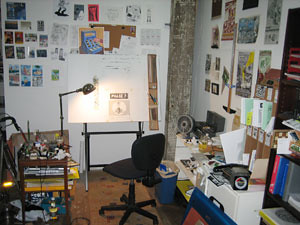
Alec's studio.
Comics: PHASE 7, The Dvorak Zine
Website: http://alec-longstreth.com/
Making comics since year of: 2000
Art education/schools attended: Oberlin College (Theatre/Computer Science), Pratt Institute (Illustration)
Tools
Pencils: Mechanical Pencil (save the trees!) with hard lead 4H or 3H, which erases completely with a white Staedtler drafting eraser. I will sometimes bust out the non-photo blue lead if I am penciling something extremely complex (a 2-color "layers" effect makes things easier to visualize).
Inks: Speedball Superblack India Ink in three containers with varying strength: "weak" (watered down with Higgins india ink) which runs smooth for nibs, normal right out of the bottle for brushes, and SLUDGE (water evaporates out of the ink over time) for filling in black areas with a larger brush. When the weak thickens, I move it to the brush jar, when the brush thickens I move it to the sludge jar.
Brushes: #2 synthetic watercolor brushes--yellow handle (Cornel?) These last the longest for me and are stiff enough that the tips don't get ruined too fast. I use a modified foam cork (from a wine bottle) carved and with a hole through it, to make the brush easier to grip.
Pens: Dip Nibs! I've moved away from the 102 Crow Quill nibs as they are too finicky, demand too much cleaning and often splatter. Instead, I do all of my crosshatching with the Hunt 513EF "mapping" nib. Since most my art is shrunk down, it has the same crowquill feel, only a little thicker, so it moves around a little more easily. B1, B5, B6, C3 speedball nibs for various tasks such as panel borders, lettering, word balloons, etc.
Koh-I-Noor Rapidograph #2 (.6mm) for all sketchbook work as well as lettering on quicker Comics. I also use the biggest one for panel borders when I'm away from my ink jars.
Pentel Japanese Brush Pen - For sketchbook stuff and non-pro illustration work (website stuff, etc). Has cartridges that last
fairly long, but ink turns grey under erasing.
Paper: Strathmore Bristol (yellow cover) Smooth Finish (wooden blocks) for pen & ink nib crosshatching style, Vellum Finish (colored balls) for brush work.
Lettering: More and more my rapidograph, but I still use a B6 nib for my best work that I rule out and everything.
Color: Photoshop
Layout/ Composition: InDesign
Convention Sketches (when different from illustrations done in the studio): Rapidograph /Brush Pen
WHITE OUT: I started using those Bic White-Out pens but then moved to little tubes of opaque white gouache. Now I use PRO-WHITE which rules!!! Remember, you can reactivate it with a little water, so just glop some onto a scrap piece of paper or something!
Tool timeline, starting from when you began drawing in any serious way until the present, and what spurred the changes: Started with ballpoint pens, moved to rapidograph, then to dip nibs, then from 102 crowquills to 513EF mapping nibs, then to brushes. Mostly just trying to find the style and look that felt the best for me.
What tools you'd never use, and why: Ballpoint pens, microns, any kind of marker - NOTHING is as black, or holds up as well as india ink!
And lastly, any advice you'd like to give: It doesn't matter WHAT you draw with, as long as it reproduces properly. Do some tests with a scanner or a photocopier and figure out what looks the best and feels the best for you!